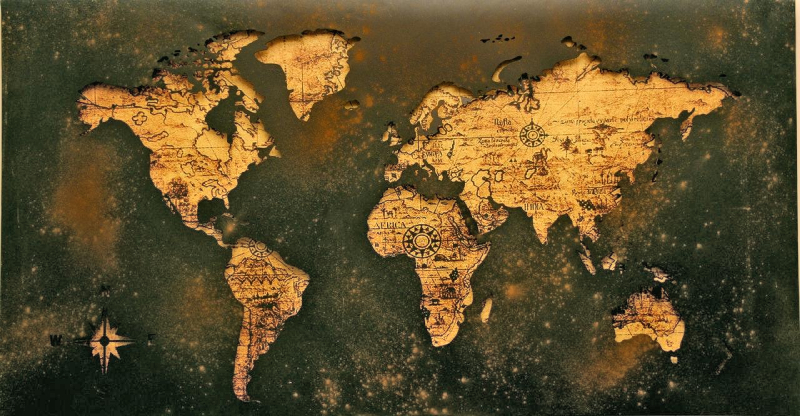GEOGRAPHY
CONVECTION CURRENT THEORY:
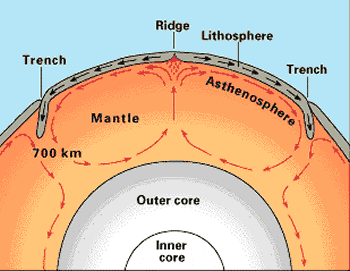
- Convection Current Theory is the soul of Seafloor Spreading Theory.
- Arthur Holmes in 1930s discussed the possibility of convection currents in the mantle.
- These currents are generated due to radioactive elements causing thermal differences in the mantle.
- According to this theory, the intense heat generated by radioactive substances in the mantle (100-2900 km below the earth surface) seeks a path to escape and gives rise to the formation of convection currents in the mantle.
- Wherever rising limbs of these currents meet, oceanic ridges are formed on the seafloor due to the divergence of the lithospheric plates (tectonic plates), and wherever the falling limbs meet, trenches are formed due to the convergence of the lithospheric plates (tectonic plates).
- The movement of the lithospheric plates is caused by the movement of the magma in the mantle.
OCEAN FLOOR MAPPING:
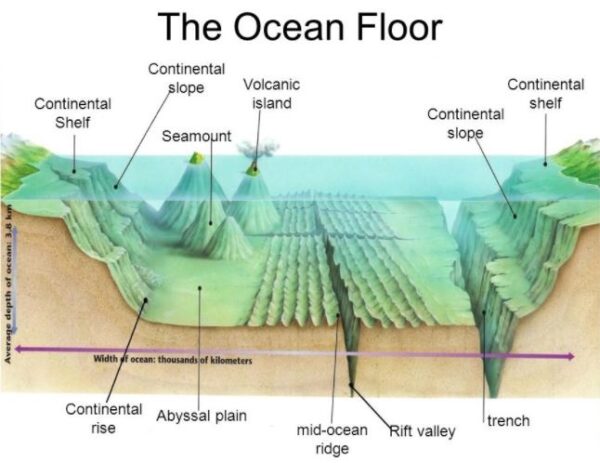
- During 1940s and 1950s, geographers used sonar-equipped vessels and crisscrossed the oceans collecting ocean-depth profiles of the seafloor beneath them. The survey data was used to create three-dimensional relief maps of the ocean floor.
- They studied the different landforms and they found tremendous landform diversities even more than continents.
- The ocean floor is found to be having mountain ranges, plains, canyons, submarine ridges, deep trenches and other relief features. It has also been found that along the mid-oceanic ridges, volcanic eruptions are most active.
- Further, the dating of rocks suggests that the oceanic crust rocks are much younger than the continental rocks. Also, the rocks which are equidistant from the crest of oceanic ridges on both sides have been found with utmost similarities in terms of their age, constituents, chemical composition and magnetic properties. And the sediments on the ocean floor near the ridge have been found to be thinner.
- Continental Margins: These form the transition between continental shores and deep-sea basins. They include continental shelf, continental slope, continental rise and deep oceanic trenches.
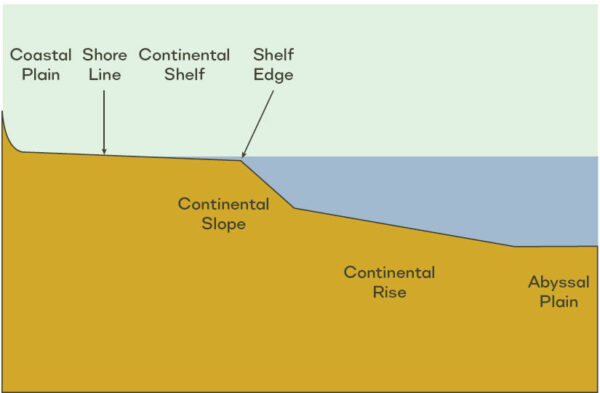
- Continental Shelf: There is no clear or well-defined line separating oceans from the continent. In fact, continents do not end abruptly at the shoreline. They slope seaward from coast to a point where the slope becomes very steep. This shallow submerged extension of the continent is called as the Continental Shelf.
- Continental Slope: The continuous sloping portion of the continental margin, seaward of the continental shelf and extending down to the deep sea floor of the abyssal plain, is known as Continental Slope.
- Continental Rise: The continental rise is a low-relief zone of accumulated sediments that lies between the continental slope and the abyssal plain. It is a major part of the continental margin, covering around 10% of the ocean floor.
- Abyssal Plains: These are the extensive plains that lie between the continental margins and mid-ocean ridges. The abyssal plains are the areas where the continental sediments that move beyond the margins get deposited.
- Seamounts: A seamounts are undersea mountains formed by volcanic activity that rises from the ocean floor but that does not reach to the water’s surface, and thus is not an island, islet or cliff-rock. Seamounts with a flattened top are called as Guyots or Table mounts.
- Volcanic Islands: Volcanic islands occur in ocean basins (such as the Hawaiian Islands) or on or near ocean ridges (e.g., St. Paul Rocks and Ascension Island in the Atlantic Ocean). They are large volcanoes erupted on the seafloor whose tops have emerged above sea level.
- Mid-ocean ridge: The mid-ocean ridge is a continuous range of undersea volcanic mountains that encircles the globe almost entirely underwater. It is the longest mountain chain on the surface of the earth though submerged under oceanic waters. It is characterized by a central rift system at the crest, a fractionated plateau and flank zone all along its length. The rift system at the crest is the zone of intense volcanic activity.
- Trench: Oceanic trenches are topographic depressions of the seafloor, relatively narrow in width, but very long. These oceanographic features are the deepest parts of the ocean floor.
Questions rose from ocean floor mapping:
Q:1) Why Ocean crust not older than mid-Mesozoic?
Q:2) Why age of the rocks increase away from mid-ocean ridge?
Q:3) Why sea-mounts deformed at trenches?
SEA FLOOR SPREADING THEORY:
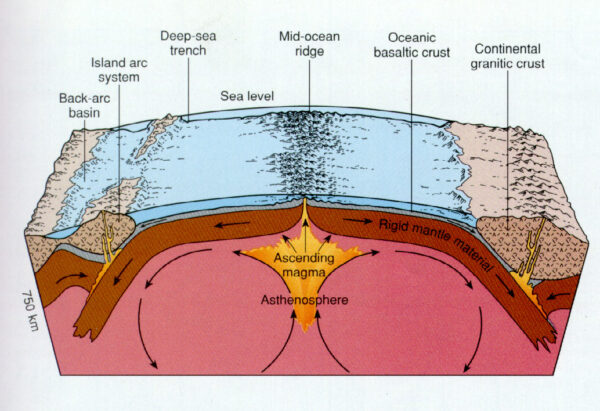
- In 1960s Harry Hass and Dietz answered the questions regarding ocean mapping using convection theory.
- They revealed the mystery of mid-oceanic ridge and trenches.
- Seafloor spreading is a process that occurs at mid-ocean ridges, where new oceanic crust is formed through volcanic activity and then gradually moves away from the ridge.
- The idea that the seafloor itself moves (and carries the continents with it) as it expands from a central axis was proposed by Harry Hess.
- According to this theory, the intense heat generated by radioactive substances in the mantle seeks a path to escape and gives rise to the formation of convection currents in the mantle.
- style=”margin-bottom: 15px;”Wherever rising limbs of these currents meet, oceanic ridges are formed on the seafloor and, wherever the descending limbs meet, trenches are formed.
- Adds new material to the ocean floor while pushing older rocks away from the ridge.
- New ocean floor forms along cracks in the ocean crust as molten material erupt from the mantle spreading out and pushing older rocks to the sides of the crack.
- The new ocean floor is continually added by the process of sea-floor spreading.
- The ocean floor that gets pushed due to volcanic eruption at the crest sinks down at the oceanic trenches and gets consumed.
- New seafloor is generated from the upper mantle at the rising limbs of the convection currents at the mid-oceanic ridges, spreads laterally outward and is eventually subducted, or consumed, at the falling limbs of the convection currents at the margins of ocean basins.
- At the descending limb, the ocean floor collides with the continental floor. During collision the heavy layer will subduct into the mantle and it will break up, cracked, melt and get destroyed.
- Oceanic floor is heavier than Continental floor.
- Subduction may also occur between two regions of oceanic crust, with older, denser sections under thrusting younger, less-dense ones.
- Out of two oceanic layers, the oceanic layer which is the lengthy one will be the heavier one and gets destroyed.
- Ocean floor act like conveyor belt.
- Ocean floor – cyclic process – 300 million years. That why maximum age of the rocks which are found on the ocean floor is not more than 300 million years.
